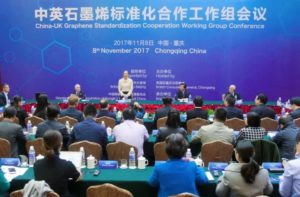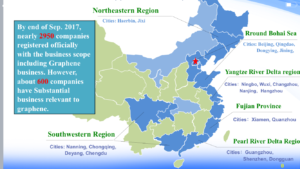17th November 2017 Chongqing
UK-China Join Hands in Standardising Global Graphene Practices
Last week in Chongqing, China’s manufacturing hub, the first UK-China Graphene Standardisation Cooperation Working Group Conference agreed to work together to submit a co-authored International Organization for Standardization (ISO) proposal by February 2018. The Conference, part of a SIN funded mission, was opened by the UK’s Minister of Trade & Export Promotion, Baroness Rona Fairhead and the Director General of the Standardization Administration of China, and allowed experts from the British Standards Institute (BSI) and National Physical Laboratory (NPL) to promote the UK’s leading role in the commercialisation of this disruptive technology to key officials, academics and industry figures from across China. The UK experts also visited two graphene industry clusters and participated in the UK Industrial Strategy Forum at the China International Industrial Fair in Shanghai.


Baroness Fairhead makes her opening remarks and shakes hands with Tian Shihong, Director General, Standardization Administration of China
Why is collaboration on standards so important for graphene?
In simple terms, a standard is an agreed way of doing things. Standards can easily become barriers when two parties can’t agree on each other’s ways, making them of huge importance on international trade patterns.
Graphene, isolated in 2004, is the thinnest material possible and ultra-light, and at the same time extremely strong (200 times stronger than steel) and flexible. These outstanding qualities make graphene a disruptive technology that will open up new markets and replace existing technologies or materials in areas worth potentially billions of GDP. Research institutes across the world are pursuing the commercialisation of graphene. However, the lack of well-established international standards could slow down the speed of adoption, lead to costly duplication and competition that hinders trade.
The UK was the first country in the world to form a national standards body – the British Standards Institute (BSI), and continues to be a global leader of standard setti ng and the R&D and commercialisation of graphene. In September 2017, ISO published the first UK-developed graphene international standard with the National Physical Laboratory (NPL) as the author – ISO/TS 80004-13: Nanotechnologies – Vocabulary – Part 13: Graphene and other two dimensional materials. In partnership with the renowned National Graphene Institute (NGI) of Manchester University, NPL has published a Good Practice Guide No.145: Characterisation of the Structure of Graphene just this month.
ng and the R&D and commercialisation of graphene. In September 2017, ISO published the first UK-developed graphene international standard with the National Physical Laboratory (NPL) as the author – ISO/TS 80004-13: Nanotechnologies – Vocabulary – Part 13: Graphene and other two dimensional materials. In partnership with the renowned National Graphene Institute (NGI) of Manchester University, NPL has published a Good Practice Guide No.145: Characterisation of the Structure of Graphene just this month.
(the picture above) Dr. Shi Haofeng of Chinese Academy of Sciences gives a tour of the graphene facilities of Chongqing Institute of Green and Intelligent Tchonlogy to Tim Prior (NPL), Katerina Busuttil (BSI), Dr Andrew Pollard and Stephanie Kitchen (both NPL)
Why are the UK and China natural partners?
UK is leading EU’s ‘Graphene Flagship’ programme with world-leading R&D capacity and has patented many graphene technologies. At the Chongqing conference, NPL and BSI showcased the application highlights of the National Graphene Institute (NGI), including composites, membrane and coating, temperature sensor, energy storage, printing. Opened in March 2015, NGI received £61million investment from the UK government to construct as part of the Manchester University and an extra £60million to establish a new Graphene Engineering and Innovation Centre to open in 2018.
China is the strongest performer in Asia Pacific. The Chinese graphene market alone was valued at US$ 16.3 million in 2015 and is projected to reach US$ 200million by 2020. Chinese official statistics show that by September 2017, there are 2950 companies registered with graphene as a business scope, forming 6 major industry clusters across China (the right picture shows). However, only 600 of them have substantial business relevant to graphene. Powder and film are the two major forms of graphene products, widely applied in sectors such as lithium-ion battery and supercapacitor, anticorrosive paint, thermal management, healthcare (i.e. clothing and therapy products), composite materials, electrical conductive tyre, lubricant and metal alloy.

Collaborating on graphene standards will therefore reduce technical barriers to trade and joint R&D in an area that is a strength for both countries with huge market potential.
Written by Rebecca Jiang, UK Science & Innovation Officer China (rebecca.jiang@fco.gov.uk)